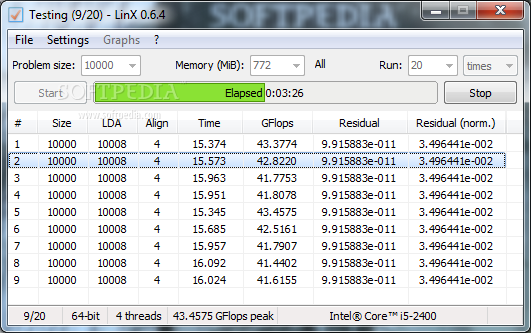Linx 0.6.4 Avx Edition
(Update: 19 Feb, 2011) Concerning the AVX issue for Sandy Bridge: According to the tests I've seen, Sandy Bridge at 5GHz+ frequency is able to output 100+ GFlops with AVX enabled with little effort. To make sure that you have AVX used you need to do the following: install Windows 7 Service Pack 1; download and use the latest version of LinX (you can find the link above); either disable HT or tell LinX to run on 4 threads (for 4 core chips, etc.) if you have HT enabled (current Linpack is poorly optimized for Sandy Bridge only chips; telling it to run on the number of threads corresponding to the number of enabled physical cores doesn't just improve performance but also slightly increases stress levels). (Update: 18 Apr, 2011) Run LinX on all the available threads (4 for HT off, 8 for HT on assuming all 4 cores are enabled) from now on. This is mandatory. It appears that the new Linpack libraries fix this bug.

Full internal name: org.xtremesystems.LinX. Project site. 0.6.4: SHA-1 or SHA-256: 055a5da3ccd32d9e615e2e460aa610b3de445437: Type: one file.

Using AVX enabled LinX increases stress levels. To separate those using AVX from the rest, I am going to divide 5GHz Club into 2 categories: 'Over 100 GFlops' and 'Under 100 GFlops'. This seems to be the only way of determining whether someone uses AVX or not for sure. To make sure you get into 'Over 100 GFlops' category, make sure that at least one of your loops has 100+ GFlops performance. Obviously, it has to be visible on the screenshot of your submission. Taken from Zalbard LinX 4.5ghz Stable thread.
Your system can start to show signs of problems due to various reasons. A way to see if it can still live up to expectations is with a dedicated testing utility. LinX is a benchmarking tool that supports Intel and AMD CPUs and aims to test system stability and detect potential hardware errors. Suitable for beginners and experts alike In contrast to other similar solutions in the same category, LinX relies on a more user friendly approach, with a very clean interface and intuitive menus that help both beginners and experienced users to take advantage of its features.
Easy configuration process Designed to solve systems of linear equations, LinX seriously stresses up the computer while it performs a new test, so we recommend you to avoid using the workstation during this period. The main window of the application allows you to configure the problem size and to decide how many times you wish to run it, as well as to adjust the allocated memory. There's a settings menu that can be used to configure whether to use 32-bit or 64-bit mode, the number of threads, priority class, data alignment and OS memory. Prompts you when problems are encountered LinX also boasts automatic error control, so the test can be automatically stopped once the application detects an error. It supports Intel HyperThreading and is able to import reports generated by Everest and Speedfan. Light, but sufficient support offered Although it doesn't include a help file to guide users throughout the entire testing process, LinX still comes with a simple text document that comprises information on every single feature regarding the app, so beginners may have a look in there as well. To end with Overall, LinX is a decent tool to assess the stability of your system by performing a set of in-depth test that may reveal hardware errors.

Linx 0.6.4
It requires little time to get acquainted with what it has to offer and it can provide just the right info in case your system needs repairs or an upgrade.